Human Orbital Spaceflights
![]()
International Flight No. 216STS-92Discovery (28)100th Space Shuttle missionUSA |
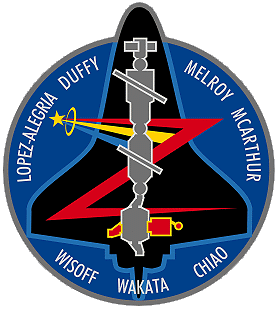 |
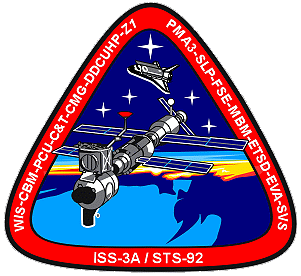 |
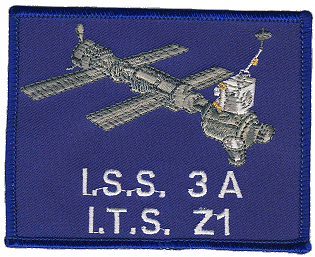 |
||
![]()
Launch, orbit and landing data
walkout photo |
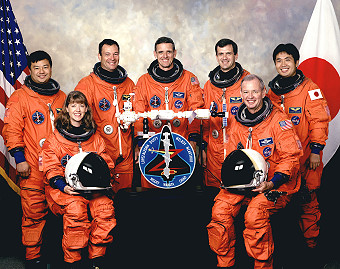 |
||||||||||||||||||||||||||||||||
alternative crew photo |
|||||||||||||||||||||||||||||||||
alternative crew photo |
|||||||||||||||||||||||||||||||||
alternative crew photo |
Crew
| No. | Surname | Given names | Position | Flight No. | Duration | Orbits | |
| 1 | Duffy | Brian | CDR | 4 | 12d 21h 42m 42s | 203 | |
| 2 | Melroy | Pamela Ann | PLT | 1 | 12d 21h 42m 42s | 203 | |
| 3 | Chiao | Leroy | MS-1, EV-1, IV-2 | 3 | 12d 21h 42m 42s | 203 | |
| 4 | McArthur | William Surles, Jr. "Bill" | MS-2, EV-2, FE, RMS | 3 | 12d 21h 42m 42s | 203 | |
| 5 | Wisoff | Peter Jeffrey Kelsay "Jeff" | MS-3, EV-3, IV-1 | 4 | 12d 21h 42m 42s | 203 | |
| 6 | Lopez-Alegria | Michael Eladio "LA" | MS-4, EV-4, RMS, PLC | 2 | 12d 21h 42m 42s | 203 | |
| 7 | Wakata | Koichi | MS-5, RMS | 2 | 12d 21h 42m 42s | 203 |
Crew seating arrangement
|
 |
|
||||||||||||||||||||||||||||||||
Hardware
| Orbiter : | OV-103 (28.) |
| SSME (1 / 2 / 3): | 2045-2A (3.) / 2053-2A (2.) / 2048-2A (2.) |
| SRB: | BI-104 / RSRM 76 |
| ET: | ET-104 (SLWT-9) |
| OMS Pod: | Left Pod 01 (31.) / Right Pod 03 (29.) |
| FWD RCS Pod: | FRC 3 (28.) |
| RMS: | 301 (19.) |
| EMU: | EMU No. 3006 (PLSS No. 1006) / EMU No. 3005 (PLSS No. 1005) / EMU No. 3009 (PLSS No. 1009) |
Flight
|
Launch from Cape Canaveral (KSC) and
landing on the Edwards
AFB, Runway 22.
The launch was delayed from October 06, 2000. Main objectives of fifth Space Station Assembly mission ISS-05-3A was an ISS assembly flight that brought the Z1 truss, Control Moment Gyros, Pressurized Mating Adapter-3 (PMA-3) (mounted on a Spacelab pallet) and two DDCU (Heat pipes) to the space station. The Z1 truss was the first permanent lattice-work structure for the ISS, very much like a girder, setting the stage for the future addition of the station's major trusses or backbones. The Z1 fixture also serves as the platform on which the huge U.S. solar arrays were mounted on the next shuttle assembly flight, STS-97. Over the course of four spacewalks, two teams of spacewalkers and an experienced robot arm operator collaborated to install the so-called Z1 (Z for zenith port) truss structure on top of the U.S. Unity connecting node on the growing station and to deliver the third Pressurized Mating Adapter (PMA-3) to the ISS for the future berthing of new station components and to accommodate shuttle dockings. The orbiter rendezvoused with the International Space Station (ISS) on Flight Day 3 at a time based on ISS-orbiter phasing. The orbiter performed a minus R-bar approach to the ISS to protect communications with Russian ground sites and docked with Pressurized Mating Adapter (PMA) 2 on the forward common berthing mechanism (CBM) of Unity. If beta angles exceed 45 degrees, the ISS may need to perform a 90-degree roll to ensure adequate power production. If this occurs, the orbiter will have to perform a 90-degree yaw during the approach. The primary pre-rendezvous activities included checking out the orbiter's robotic arm, the extravehicular maneuvering units (EMUs), the Ku-band antenna, the orbiter docking system (ODS), and the ground command system. It may be necessary to power down the station's systems to minimize battery discharge during solar array feathering. The power-down was performed at approximately 2 hours before the terminal phase initiation, or Ti, burn. Next the orbiter rendezvous radar was activated, but it was not used until after the normal course correction burn. The crew then powered the ODS and activated the docking lights at approximately 1 hour before the Ti burn. The Ti burn was performed when the ISS was ready for docking. If ISS power or thermal concerns arise, a Ti delay burn will be performed instead of the Ti burn. Zvezda and Zarya solar arrays were feathered (or positioned) and locked when the orbiter was 150 feet (45.7 meters) from the station. Feathering was initiated by a command to reposition and hold each beta (and alpha) joint at a predetermined angle, which limited the induced loads. The ISS automatically switched to free drift at capture, and the orbiter went to free drift to avoid imposing excessive loads on the orbiter docking system (ODS). Light-emitting diodes (LEDs) on PMA-2 blinked when the ISS was in free drift. The crew was able to see the red indicators through the overhead window on the orbiter's aft flight deck and verify that the ISS was in the free-drift mode. The ODS began the automatic rigidization and retraction process, and its capture hooks were closed. Then the ODS was deactivated, Zvezda and Zarya solar arrays resumed sun tracking, and the orbiter-ISS stack maneuvered to the mated attitude. Discovery docked with ISS on October 13, 2000. After the orbiter docked with the ISS, the crew entered PMA-2, took an air sample from Unity, and activated the Unity cabin fan to scrub the atmosphere. After a 2-hour scrub, the crew took another air sample. On flight day 4, the crew unberthed the Z1 segment of the station's integrated truss structure from the orbiter payload bay and mated it with Unity's zenith CBM port. After the CBM operations was completed, the crew entered Unity and Zarya. Over the next four days, crew members conducted four spacewalks to connect umbilicals and configure hardware for future operations. The crew re-entered the ISS on flight day 9 to transfer EMU hardware and complete any remaining entry or transfer tasks. Later the transfer of equipment and supplies into the ISS started. On flight day 3 the Z1 Truss was installed. ITS Z1 is an early exterior framework to allow the first U.S. solar arrays on flight 4A to be temporarily installed on Unity for early power. Pressurized Mating Adaptor (PMA) 3 provides a place for an orbiter to dock with the U.S. segment of the International Space Station (ISS). PMA-3 includes mechanical interfaces, spacewalk hardware and thermal control equipment, electrical power subsystem (EPS) and command and data handling (C&DH) passthroughs. PMA-3 was not used for docking until Mission 4A/STS-97. PMA-3 provides a hard-line 1,553 data bus connection between the orbiter and Unity via X-connectors on the PMA -3 androgynous peripheral attachment system (APAS), which interfaces with the orbiter docking system (ODS). Umbilical connections between Unity and PMA-3 complete this hard-line path. This path allows the orbiter interface units (OIUs) and orbiter portable computer system machines to talk on the ISS orbiter buses. The Z1 is the base structure for the U.S. solar array. It includes two plasma contactors, two DC-to-DC converter units (DDCUs), four control moment gyro (CMG) assemblies, part of one string of the S-band communications system, one Ku-band communications system, primary and secondary power distribution, thermal control system hardware, mechanical interfaces, and EVA/extravehicular robotics (EVR) hardware. The S-band communications system consists of two redundant strings, each of which comprises three on-orbit replaceable units (ORUs) and two antennas, the baseband signal processor (BSP), the Tracking and Data Relay Satellite System (TDRSS) transponder, and the antenna RF group, which includes a low-gain antenna and a high-gain directional antenna. The first EVA was performed by William McArthur and Leroy Chiao on October 15, 2000 (6h 28m). The S-band Antenna Support Assembly was relocated on the Z1 Truss. The Z1 starboard bulkhead thermal shrouds were removed and stowed. The port Extravehicular Tool Storage Devices were released and transferred from the Spacelab Logistics Pallet to the Z1 Truss. The Z1-to-Node 1 umbilicals, or cables, were connected. The Space-to-Ground Antenna dish was installed onto the boom and the boom was deployed. Before Z1 was mated with Unity, the zenith active common berthing mechanism (ACBM) was activated and checked out. This procedure was initiated by applying power to the controllers that control the ACBM. Once power has been applied, the 20 individual controller channels began a power-on self-test (POST). The POST results were relayed after a master motor controller had designated during the initialization. The master controller controls all ACBM functions and reports statuses that it gathers from the slave controllers. The early portable computer system (EPCS) reports the status of the power-up and remote power controller module (RPCM) switches, and the crew reviews and compares the reported status to expected values. The crew received the current overall CBM command status, subsystem identification (latch/bolt controller), time, status of the motor current, motor speed, bolt load, and shaft position. This operation also set all powered bolt and latch controller positions. Because the system was initialized, these positions had a reading of zero. If controller channel faults are present, fault detection, isolation, and recovery (FDIR) activities were initiated. If no faults were detected, the crew continued with the ACBM checkout. The crew members tested the bolts by turning them two turns out and three turns in before berthing to ensure that they were operable. The capture latch actuators fully deployed the four capture latches to ensure that they were operable before element berthing began. The capture latches were then moved from the deploy position to the capture position as part of the pre-berthing latch operation testing. The capture latches must then redeployed before Z1 was positioned in Unity's zenith ACBM capture envelope. The crew used the same procedure to perform a capture latch deploy test. After the ACBM was checked out successfully and the capture latches were extended, the robotic arm was maneuvered to the grapple position. Z1 was grappled, and the crew unlatched the payload retention latch assemblies (PRLAs) and the active keel assembly (AKA) holding Z1. The orbiter is taken to free drift, and the arm unberthed and maneuvered Z1 to a low hover position. After some orbiter attitude cleanup, the orbiter was taken to free drift again, and Z1 was maneuvered to the premate position. After more attitude cleanup, the orbiter was taken back to free drift, and Z1 was maneuvered to the capture position. The orbiter remained in free drift until initial bolt loading (ABOLT) occurred. When the bolts were ready, they were taken to the final preload bolt (FBOLT) values by tightening the bolts, four at a time. An adequate pressure seal was achieved if 15 of the 16 bolts or 14 of 16 (nonadjacent) bolts were at the FBOLT load. After FBOLT was achieved, the capture latches were commanded from the capture position to the close position. Power was then removed from Unity's zenith ACBM. The second EVA by Peter Wisoff and Michael Lopez-Alegria occurred on October 16, 2000 (7h 07m). The Pressurized Mating Adapter 3 was grappled by the shuttle's robotic arm and installed on the Unity Connecting Module nadir port. The primary and secondary cable bundles were connected between the Pressurized Mating Adapter 3 (PMA-3) and the Unity Module. Also, latches were opened on the Z1 Truss Before PMA-3 was mated with Unity, the nadir ACBM was activated and checked out. This was initiated by applying power to the controllers that control the Node 1 nadir ACBM. After power was applied, the 20 individual controller channels began a POST. The test results were relayed after a master motor controller was designated during the initialization. The master controller controls all ACBM functions and reports statuses that it gathers from the slave controllers. The EPCS reports the status of the power-up and RPCM switches, and the crew reviewed and compared the status to expected values. The crew received the current overall CBM command status, subsystem identification (latch/bolt controller), time, status of the motor current, motor speed, bolt load, and shaft position. This operation also set all powered bolt and latch controller positions. Before berthing began, the crew members tested the bolts to ensure that they were operable, and the capture latch actuators fully deploy the four capture latches to ensure that they are operable. The capture latches were moved from the deploy position to the capture position as part of the pre-berthing latch operation testing. The capture latches must then be redeployed before Z1 was positioned in Unity's zenith ACBM capture envelope. The crew used the same procedure to perform a capture latch deploy test. After the activation and checkout of the ACBM, the crew had to visually verify that there was no debris or contamination that would prevent mating with the PCBM or cause degradation of the CBM seals. After the ACBM was checked out and the capture latches were extended, the EVA crew manually released PMA-3 from the Spacelab pallet (SLP). The arm grappled PMA-3, and PMA-3 was released from the SLP. Due to the extremely tight clearances (6 inches) between the PMA-3 and the SLP, an EVA crew member monitored the unberthing. When PMA-3 was clear of structure, it was maneuvered to the capture position. The orbiter remained in free drift until ABOLT occurred. At this point, the EVA crew connected two sets of umbilicals to PMA-3 and Node 1. An operational hold was required to prevent CBM seal scrubbing because of an excessive temperature delta between the ACBM and PCBM. At the beginning of the next flight day, the powered bolts were taken to IBOLT valued by tightening the bolts, four at a time. In order to achieve an acceptable seal between the PCBM and the ACBM, 15 of the 16 powered berthing bolts or 14 of 16 (nonadjacent) bolts must be engaged. Once the bolts have reached IBOLT status, they were taken to the FBOLT values by further tightening the bolts. After the final preload status was achieved, the capture latches were commanded from the CAPTURE position to the CLOSE position. The third EVA by William McArthur and Leroy Chiao was conducted on October 17, 2000 (6h 48m). Two DC-to-DC Converter Unit-Heat Pipes were installed on Z1. The Z1 keel pin assembly was then relocated to another location on Z1. The Z1/P6 launch locks were removed, then the Assembly Power Converter Units jumpers were also removed from the Pressurized Mating Adapter 2 to allow for installation of four Z1 cables. The starboard Extravehicular Tool Storage Device was released and transferred from the Spacelab Logistics Pallet to the Z1 Truss. During EVA-3, Mission Control Center, Houston (MCC-H) performed a DDCU-HP aliveness test to verify that the DDCU-HP blind-mate connections mated. There was no visible indication of proper connector mating, so this test mitigates the effect of a DDCU failure on follow-on flights. The orbiter crew can perform the procedure, but MCC-H had the primary responsibility. Leroy Chiao and William McArthur removed eight bolts on various parts of the SASA using the pistol grip tool (PGT). Using handrails on the SASA, William McArthur pulled the unit away from Z1, ensuring it did not contact any structure. (The SASA could survive for only 1 hour if it is not attached to a structure.) The shuttle's robot arm guided William McArthur through the unstow path as Leroy Chiao monitored progress and provided other assistance to William McArthur. Leroy Chiao rotated SASA 180 degrees so that the high-gain antenna (HGA) was pointing in the nadir direction and then aligned the mast fasteners with a stowage bracket. Leroy Chiao then secured the mast to the stowage bracket. William McArthur released a bracket from the SASA and stowed it in the Z1 stowage bin. Leroy Chiao connected cables W34-P4 and W07S-P3 to the SASA. The receptacle covers for J3 and J4 were then stowed on Z1 dummy receptacles. The ground applied heater power soon after the connectors were mated. This task must occur before the DDCU is installed because the SASA is launched in the DDCU installation locations. The immediate purpose of this task was to connect the umbilicals that provide keep-alive power to critical on-orbit replaceable units (ORUs) on Z1. Several Unity umbilicals provide APCU power to the CBMs, and these are not disconnected until CBM operations are completed later in the flight. With the exception of Russian-American conversion unit (RACU) commanding, all power-down and activation commands are sent via the portable computer system (PCS) on board the orbiter. Before the SGANT dish could be removed from its launch location, remote power controller mode Z14B-B must be verified to be operational. Once the antenna was removed from the structure, the dish cools quickly, and the antenna cannot be reinstalled in the launch location. After the orbiter docked with the ISS, the SGANT violated lower thermal limits within 20 hours, according to preflight thermal analysis. To install the SGANT, Leroy Chiao positioned himself in an APFR on the Z1 zenith bulkhead, and William McArthur moved on the robot arm near the SGANT. William McArthur unfastened two launch restraints on the antenna while Leroy Chiao held it. Leroy Chiao slided the SGANT to the hard stop on Z1 and raised it using the upper deployment handles. The SRMS positioned William McArthur near the boom attachment interface while Leroy Chiao removed the APFR and installed and entered the APFR near the boom attachment interface. Using the upper deployment handles and handles on the antenna group interface tube (AGIT), William McArthur positioned the AGIT near the boom. Leroy Chiao grasped the AGIT handles and aligned the AGIT coarse guide pins with the boom interface holes until the AGIT fine-guide pins were aligned and the SGANT dish was secured to the boom with four bolts. William McArthur then connected the J1 and J2 connectors. The intravehicular crew member verified that the RPCs feeding connector J1 are open and that closure was inhibited before mating. Before deploying the boom, the crew verified that the SGANT and transmit/receive control (TRC) heaters were active. Preflight thermal analysis showed that the SGANT were violated lower thermal limits within 30 minutes after the boom was deployed. The spacewalker on the arm removed a pip pin from the launch restraint bolt and then unfastened the bolt. The SGANT with boom was unstowed by both spacewalkers. William McArthur attached the antenna to Z1 by fastening two captive EVA bolts on the boom to the Z1 zenith bulkhead using the PGT. Two DDCU-HPs are being flown on STS-92. DDCU Z1-3B was on the starboard sidewall of the payload bay, and DDCU Z1-4B was on the port sidewall. The installation procedures for the two units were similar. After the DDCU was released, the heat pipe radiator caused heat to leak from the DDCU. The DDCU reached its survival thermal limit in one hour. William McArthur aligned the DDCU-HP on Z1, using the alignment marks on the unit with marks on the truss, and guided the box onto the aft tie-down nuts until the box was seated. When the DDCU-HP front screw was fastened to a hard stop, the front status indicator changed from UNLOCK to LOCK and the rear status indicator went from LOCK to UNLOCK. After the rear screw was fastened to a hard stop, the rear status indicator went from UNLOCK to LOCK. The ORU was installed. The DDCU continued to cool down until heater power was applied, which occurred within 1 hour of the installation on the Z1 structure. After the spacewalk, Discovery completed the second of the three station reboosts scheduled for STS-92. They fired reaction control system jets in a series of pulses of 1.4 seconds each, over a 30-minute period, gently raising the station's orbit by about 3.1 km. The fourth and final EVA by Peter Wisoff and Michael Lopez-Alegria was performed on October 18, 2000 (6h 56m). A grapple fixture on the Z1 Truss was removed. The Z1 utility tray was deployed and its umbilical launch restraints released. The Z1 Manual Berthing Mechanism latches was cycled and opened. Peter Wisoff and Michael Lopez-Alegria performed one safety protocol test -- a flight evaluation of SAFER, which means "simplified aid for EVA rescue". Once the Unity nadir ACBM was activated and checked out and the ACBM capture latches were all extended, EVA crew members Peter Wisoff and Michael Lopez-Alegria could remove PMA-3 from the Spacelab pallet (SLP). With the robotic arm attached to PMA-3, the two spacewalkers loosened the berthing bolts while deploying the capture latches. This series of maneuvers prevented asymmetrical loading on the PMA-3 from the MBM. PMA-3 must be unberthed from the SLP in daylight because cameras must be used during the procedure. Because of the tight clearances, camera views are necessary to assist the SRMS crew member. One spacewalker had to open and close the capture latches to ensure that they are operational. With the latches closed, the spacewalkers first loosened all bolts one-half turn to relieve pressure on the PCBM seal. This was done so that unloading occurred symmetrically; however, it did not have to be performed by the two crew members simultaneously. Because of the loading conditions, the crew members fully loosened and released all but the four bolts next to the MBM capture latches. The EVA astronauts fully unbolted the remaining berthing bolts simultaneously while working opposite from each other. PMA-3 was now free of all berthing bolts on the MBM ring. The remaining restraints were the four capture latches. An EVA crew member took up a position at the capture latch drive assembly and had to drive the latches at a low torque setting until they were one turn from being fully deployed. Then the latches were fully opened at a higher torque setting. After PMA-3 was moved from the envelope of the MBM, an EVA astronaut had to drive the capture latches back to their closed position for entry, first within one turn of being fully deployed at a higher torque and then to the final position at a lower torque. Because of the 6-inch clearance between the PMA-3 docking light assembly and the SLP, an EVA crew member had to monitor the unberthing. The orbiter-ISS stack had to be in free drift; once the PMA-3 was clear of the SLP, the orbiter's vernier reaction control system (VRCS) was used for attitude control. Once PMA-3 was successfully berthed and latched to Node 1, an EVA crew member could support the primary umbilical release. Michael Lopez-Alegria released launch restraints and clamped so that he could release the zero-gravity connectors and slides the thermal covers off the zero-g connectors. Michael Lopez-Alegria then released one PMA-3 primary umbilical launch fitting and disconnected the primary umbilicals from the dummy panel. The PMA-3 primary umbilical bunch was free of the PMA when the stanchion fitting was released. (A minimum of 20 pounds (9 kg) was required to release the stanchion after the EVA bolt is free.) Michael Lopez-Alegria moved to the node after releasing EVA clamp C4 and was ready to help guide the umbilical around the grapple fixture. The remaining clamps were released, and the primary umbilical was controlled to ensure that the lower part of the umbilical did not float into the path of the Peter Wisoff or the SRMS. Peter Wisoff carried the PMA-3 primary umbilical on the SRMS around the starboard side (orbiter port) of PMA-3 to the Node 1 end cone handrail, where it was temporarily secured. Peter Wisoff held the PMA-3 primary umbilical stanchion and controlled the umbilical while moving to the Node 1 end cone on the SRMS. Michael Lopez-Alegria had to help guide the umbilical around the grapple fixture and ensure that it does not become entangled. The RPCs for the PMA shell heaters were opened to provide adequate safety inhibits before connectors was mated. Before the orbiter departed, ground personnel updated the ISS vector and mass data. This data included attitude departure maneuver data, attitude hold data, post-departure mass properties, and post-departure attitude maneuver data. A navigation platform alignment was performed. Zvezda and Zarya solar arrays were commanded to stop sun tracking and were feathered to the edge-on position. The orbiter crew configured orbiter hardware for departure. This involved enabling rendezvous navigation and performing an orbiter-to-target state vector transfer. Next, the crew configured the ODS. The orbiter docking lights were activated, and orbiter power was applied to the ODS. The orbiter digital autopilot was configured for proximity operations and commanded to free drift. Orbiter interface unit (OIU) operations were terminated, and OIU interfaces were powered off. The crew undocked the orbiter from PMA-2 and performed a series of separation burns with the primary RCS jets to move the orbiter away from the ISS. Zvezda's flight control system was activated by a separation signal from the androgynous peripheral attachment system (APAS). This signal initiated a 250-second delay before Zvezda's attitude control system was activated. Separation must occur within Russian ground coverage because the APAS indicator is mechanically zero-fault tolerant and electrically single-fault tolerant. Russian ground personnel activated the attitude control system if the APAS indicator fails. Zvezda maneuvered to its post-departure attitude and returned to the XPOP flight mode. Zvezda and Zarya solar arrays resumed sun tracking. Finally, Russian segment equipment needed only during mated and departure operations (docking system, lights, etc.) were deactivated. The return to earth, planned for October 22, 2000, was delayed repeatedly due to high winds at the Kennedy landing site. The landing was finally made at Edwards Air Force Base, California. |
EVA data
| Name | Start | End | Duration | Mission | Airlock | Suit | |
| EVA | Chiao, Leroy | 15.10.2000, 14:27 UTC | 15.10.2000, 20:55 UTC | 6h 28m | STS-92 | Discovery - ISS | EMU No. 3006 |
| EVA | McArthur, William | 15.10.2000, 14:27 UTC | 15.10.2000, 20:55 UTC | 6h 28m | STS-92 | Discovery - ISS | EMU No. 3005 |
| EVA | Wisoff, Peter | 16.10.2000, 14:15 UTC | 16.10.2000, 21:22 UTC | 7h 07m | STS-92 | Discovery - ISS | EMU No. 3005 |
| EVA | Lopez-Alegria, Michael | 16.10.2000, 14:15 UTC | 16.10.2000, 21:22 UTC | 7h 07m | STS-92 | Discovery - ISS | EMU No. 3009 |
| EVA | McArthur, William | 17.10.2000, 14:30 UTC | 17.10.2000, 21:18 UTC | 6h 48m | STS-92 | Discovery - ISS | EMU No. 3005 |
| EVA | Chiao, Leroy | 17.10.2000, 14:30 UTC | 17.10.2000, 21:18 UTC | 6h 48m | STS-92 | Discovery - ISS | EMU No. 3006 |
| EVA | Lopez-Alegria, Michael | 18.10.2000, 15:00 UTC | 18.10.2000, 21:56 UTC | 6h 56m | STS-92 | Discovery - ISS | EMU No. 3009 |
| EVA | Wisoff, Peter | 18.10.2000, 15:00 UTC | 18.10.2000, 21:56 UTC | 6h 56m | STS-92 | Discovery - ISS | EMU No. 3005 |
Photos / Graphics
 |
 |
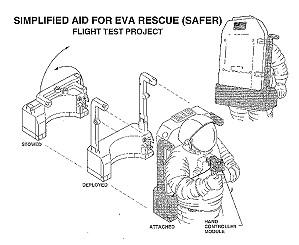 |
 |
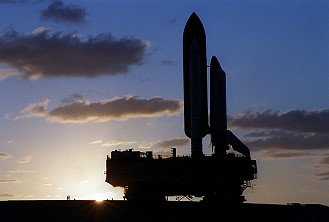 |
 |
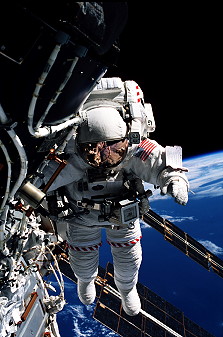 |
 |
 |
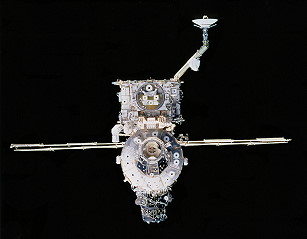 |
 |
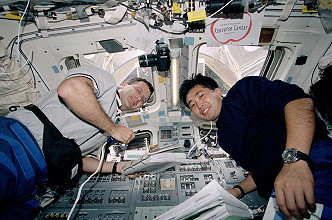 |
 |
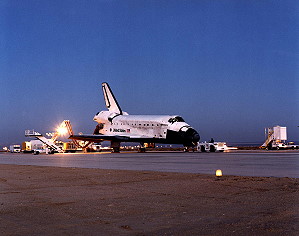 |
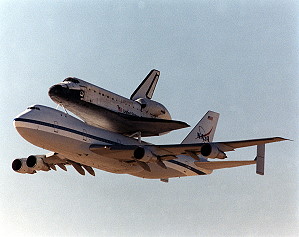 |
|
more EVA photos |
|
| © |  |
Last update on March 27, 2020.  |
 |